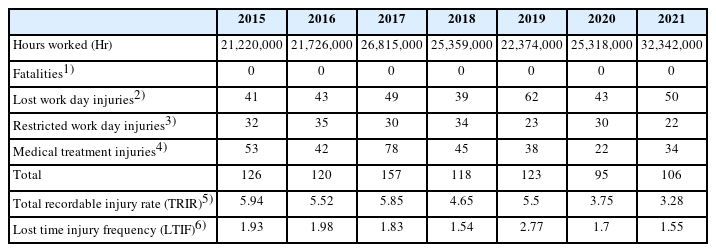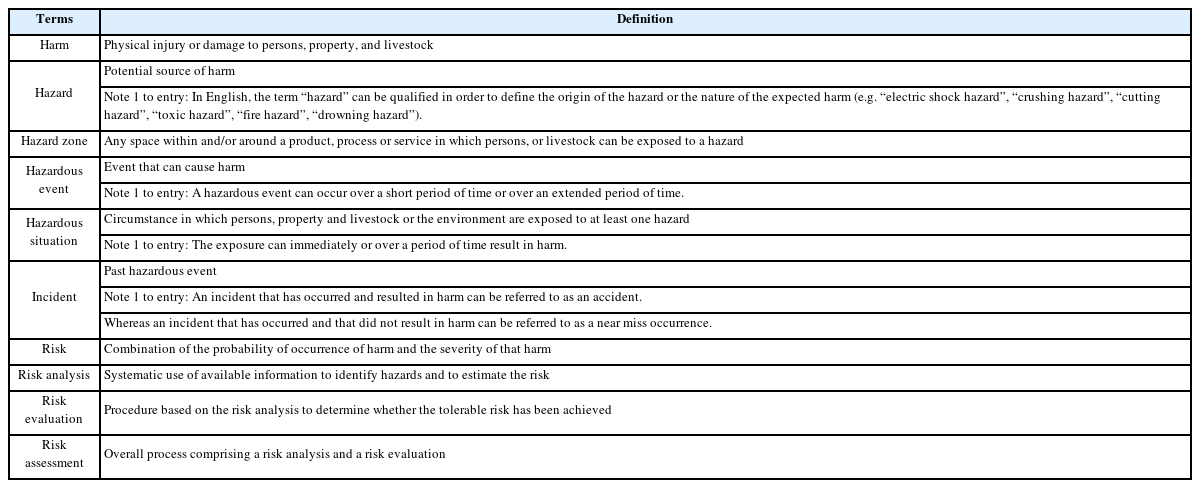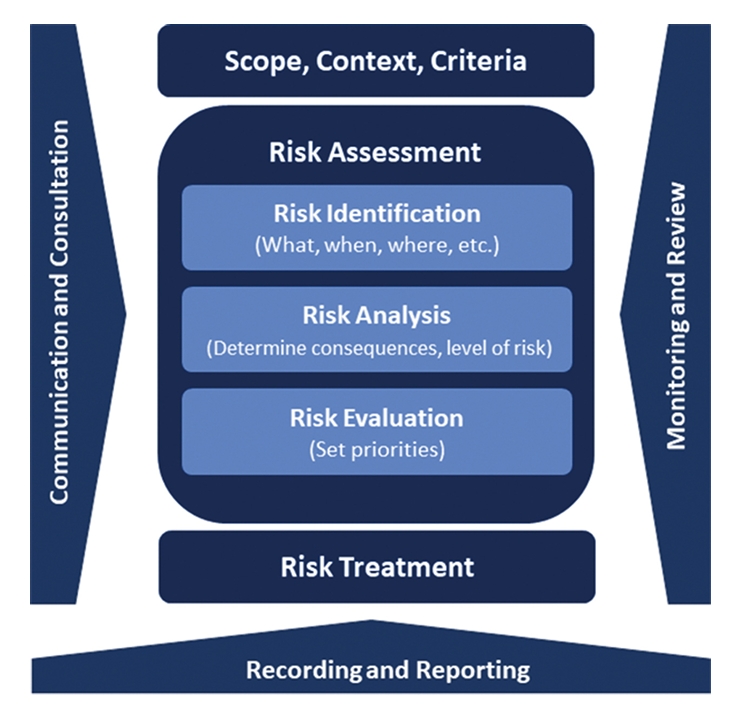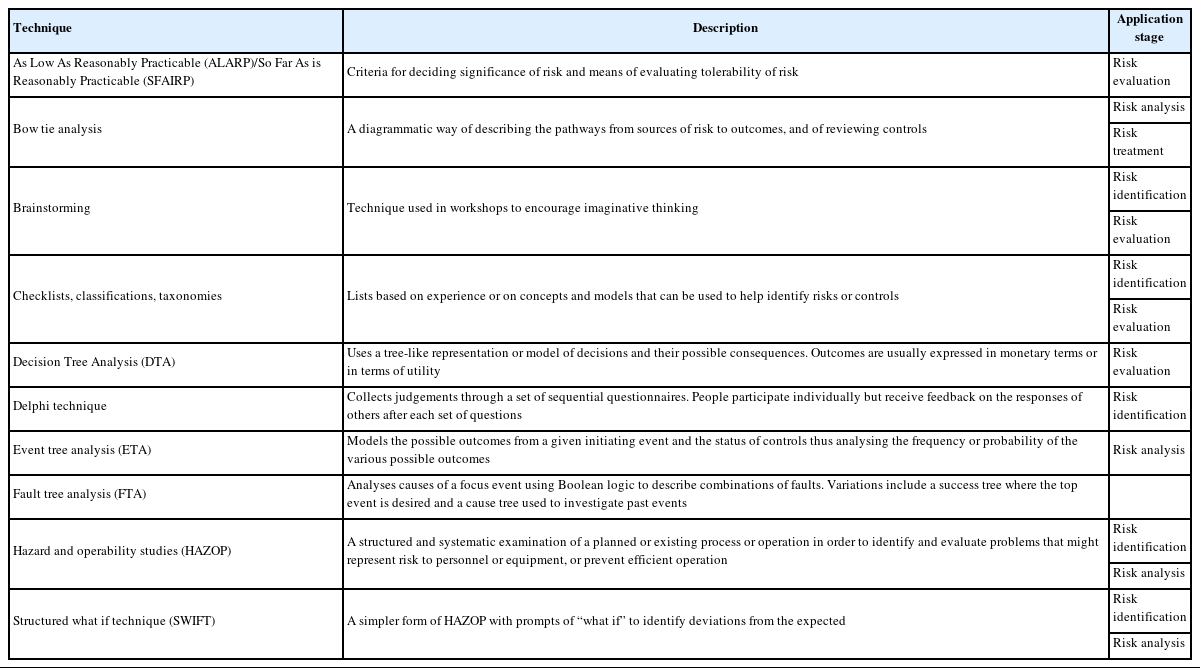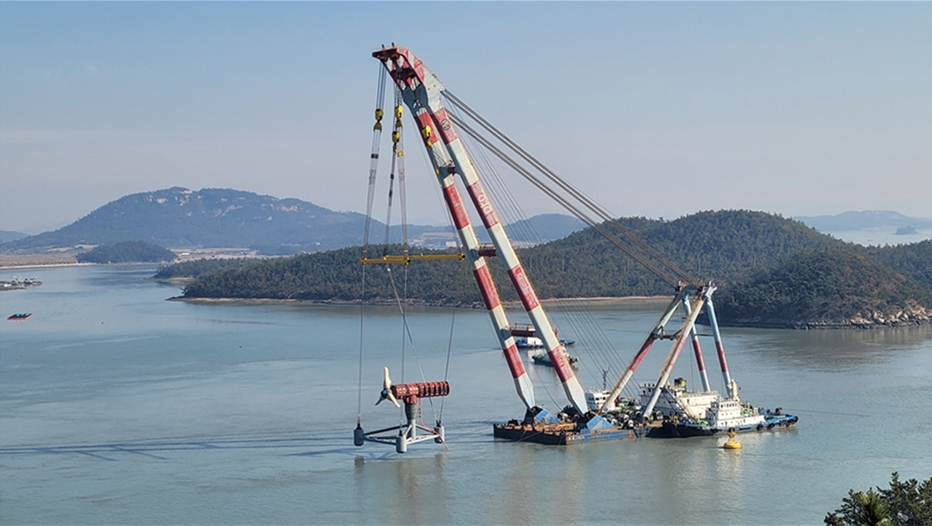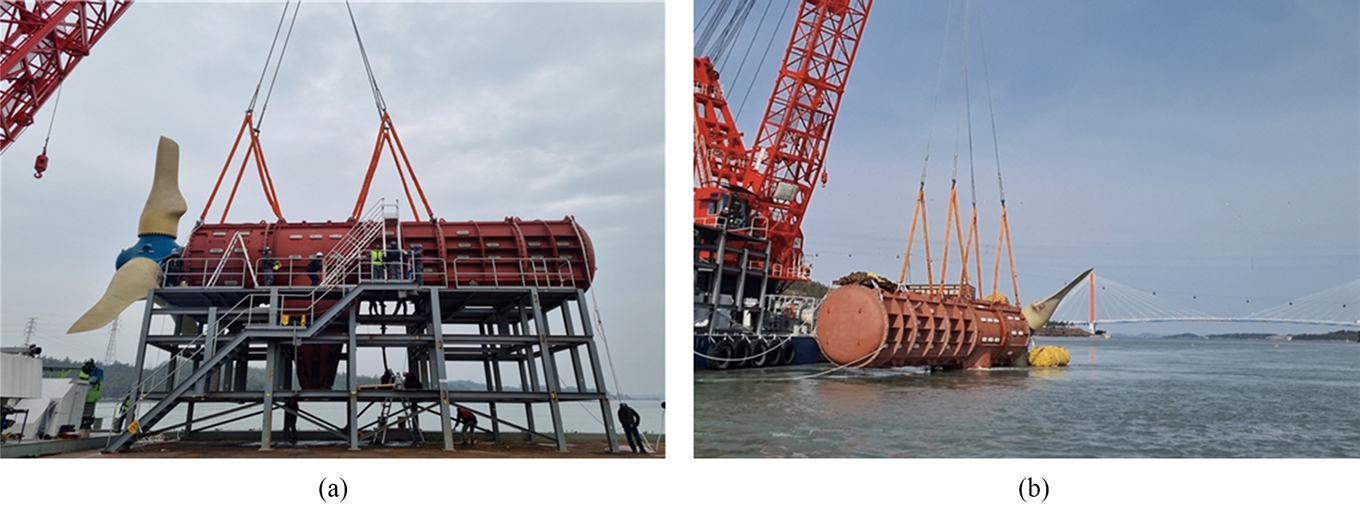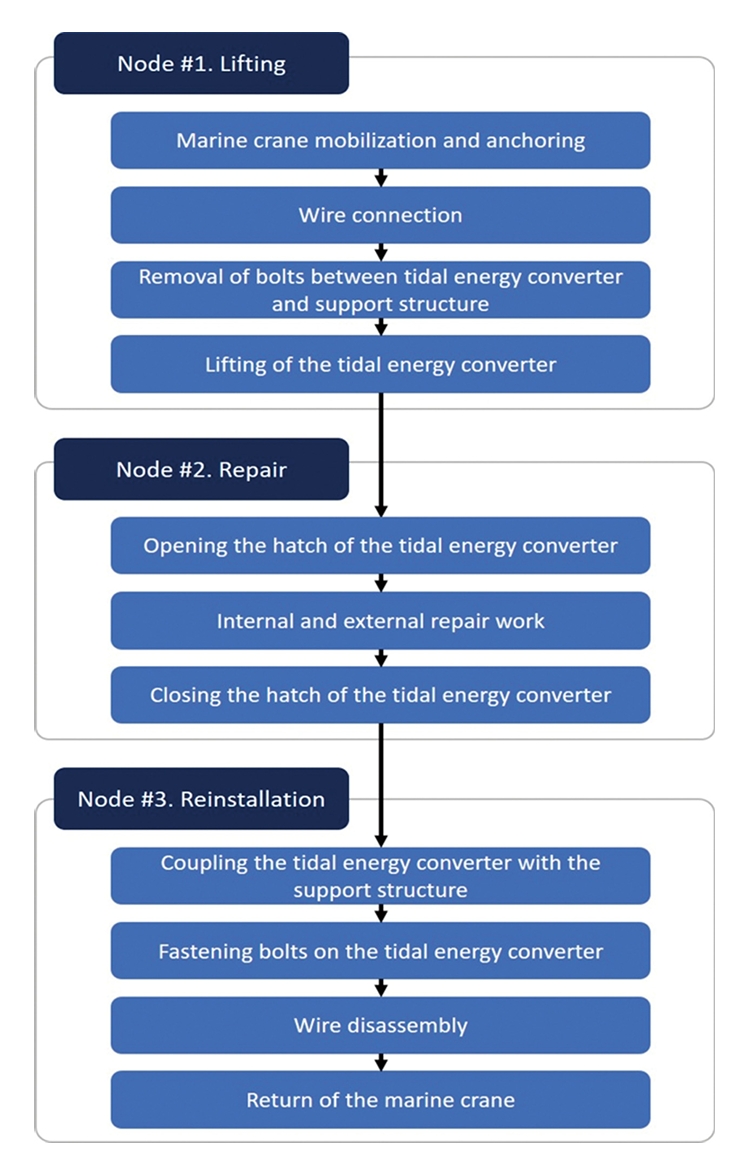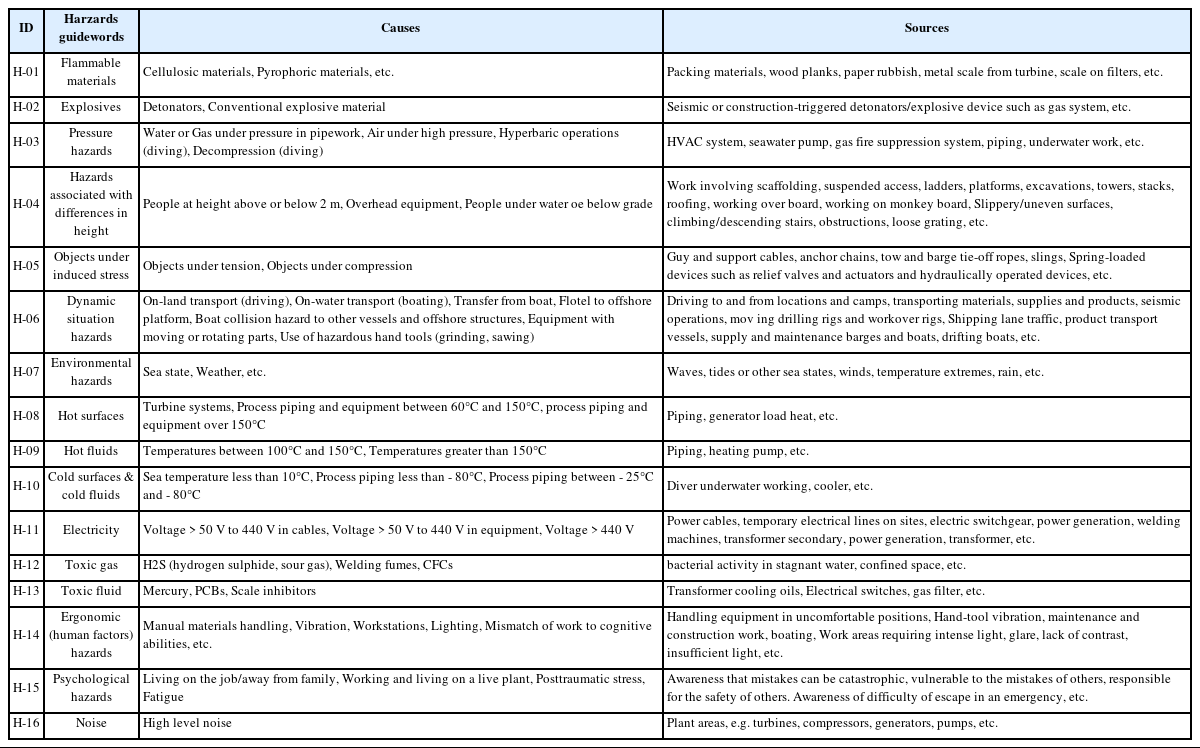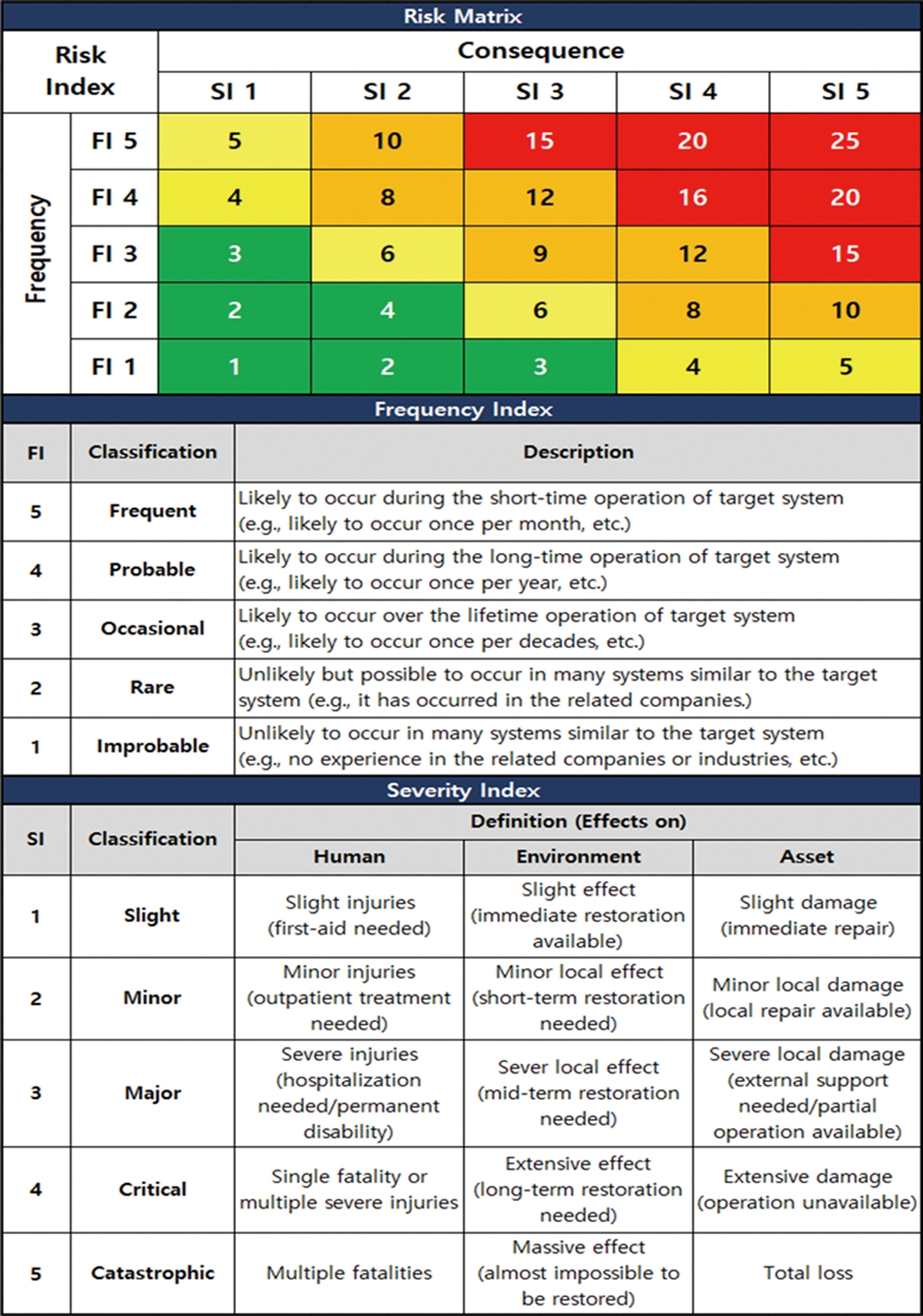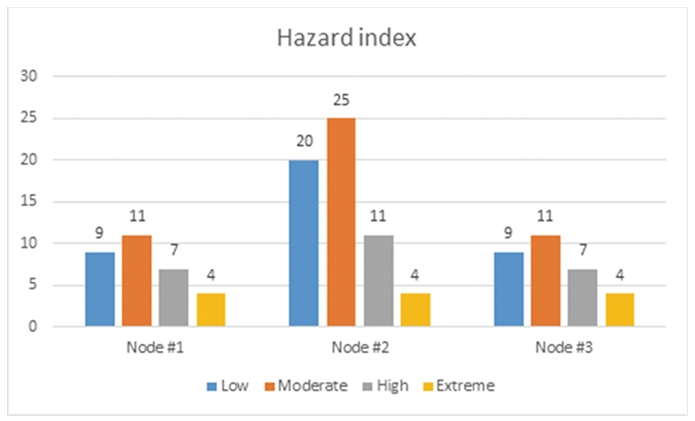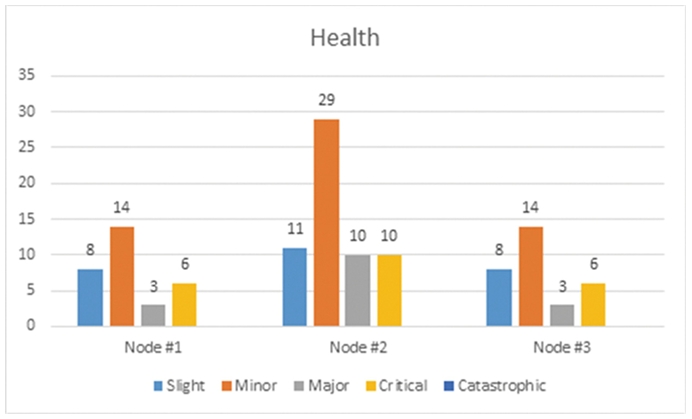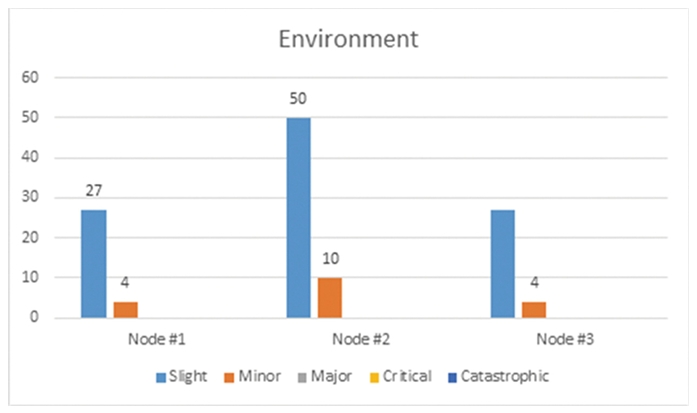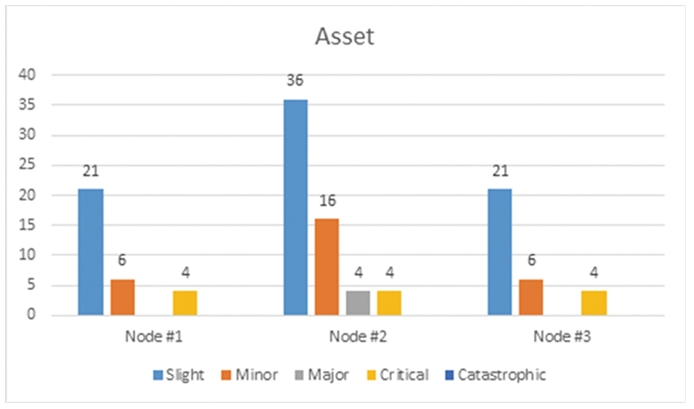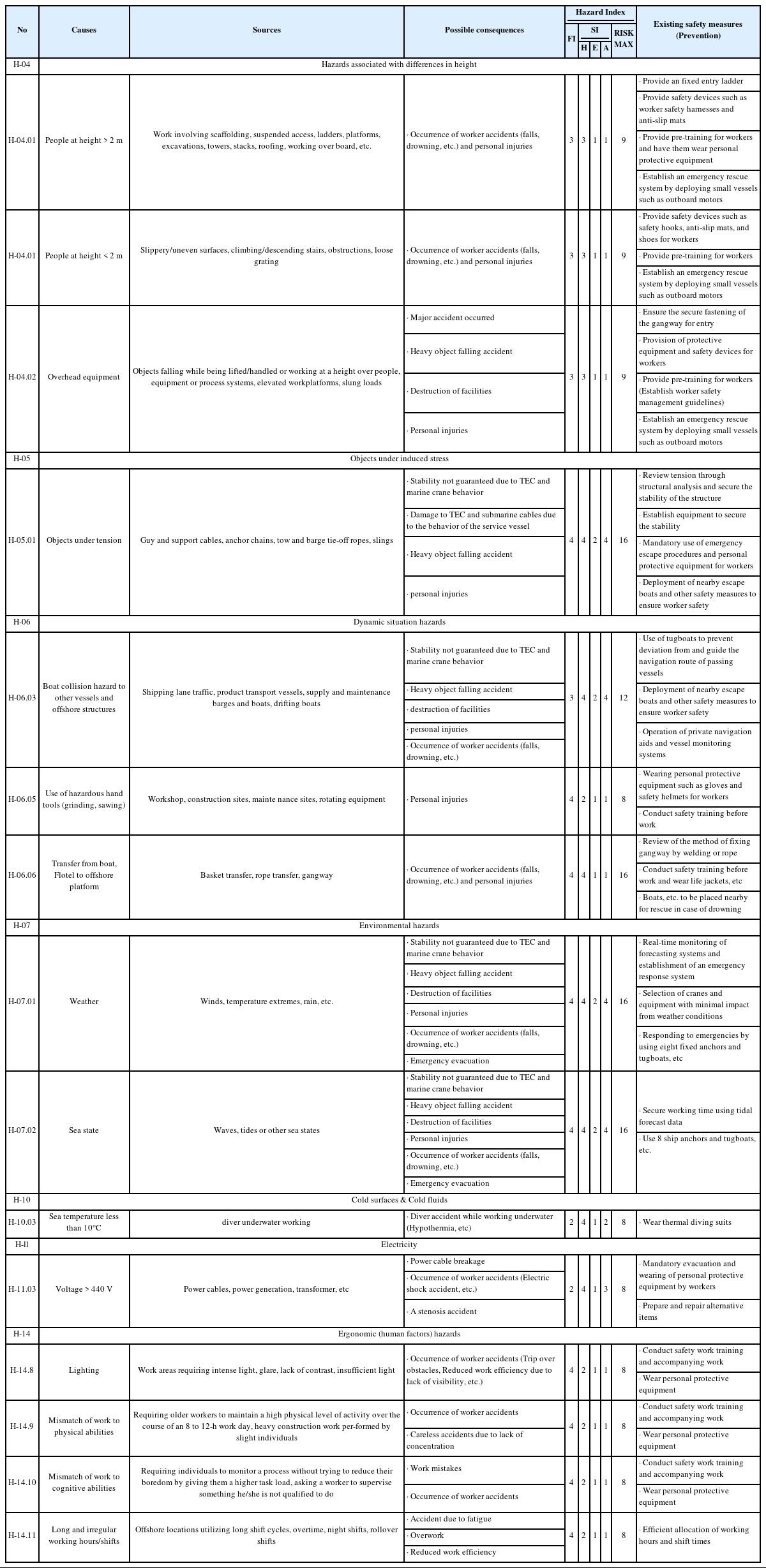1 MW 조류발전기 O&M 위험성평가 사례 연구
A Case Study on the Risk Assessment for O&M of a 1 MW Tidal Current Energy Converter
Article information
Abstract
조류발전은 조류에너지를 활용하여 전기를 생산하는 기술로서 최근 몇 년간 기술 수준의 향상으로 실해역 성능 테스트 단계에 도달하였다. 그러나 국내의 경우, 공사 경험 및 장비가 부족하고 울돌목 해역과 같은 강유속 해역에서 작업이 이루어져야 하기 때문에 해상 작업에는 다양한 위험 요인이 존재한다. 이러한 위험 요인의 감소 대책 수립을 위해 국내 산업안전보건법에서는 작업 중 발생할 수 있는 위험 요인을 사전에 식별하고 이를 관리하기 위한 위험성평가 수행을 권고하고 있다. 위험성평가는 작업 중 발생 가능한 위험 요인을 식별하고 평가하는 일련의 과정으로 사고로부터 발생하는 손실을 최소화하기 위한 것이다. 이에 본 연구에서는 1 MW 조류발전시스템의 해상 Operation and Maintenance(O&M) 작업 중 발생할 수 있는 위험 요인을 식별하고 작업자 및 환경의 안전을 확보하기 위하여 위험성평가를 수행하였다. 위험 요인으로는 해양 및 기상조건, 장비 및 인력, 작업환경 등을 포함하여 총 60개의 위험 요인을 도출하였으며, 여러 현장 전문가들의 판단에 따라 총 3회에 걸쳐 정성적 위험성평가를 수행하였다.
Trans Abstract
Tidal power is a technology that generates electricity by utilizing tidal current energy, and in recent years, with the advancement of technology, it has reached the stage of real sea performance test. However, in the case of Korea, there is a lack of construction experience and equipment, and work in fast flows such as the Uldolmok region involves various risk factors. In order to establish measures to reduce these risk factors, Korea’s Occupational Safety and Health Act recommends performing a risk assessment to identify and manage risk factors that may occur during work in advance. Risk assessment is a process aimed at identifying and evaluating potential risk factors that may arise during work, with the goal of minimizing losses caused by accidents. Therefore, in this study, a risk assessment was conducted to identify risk factors that may occur during offshore O&M work of the 1 MW tidal current energy converter and to ensure the safety of workers and the environment. A total of 60 risk factors were identified, including marine and weather conditions, equipment and personnel, and work environments, and a qualitative risk assessment was conducted three times based on the judgment of several field experts.
1. 서 론
최근 전 세계적으로 기후변화로 인한 환경 문제 및 탄소 중립 등 기후위기 대응에 적극 동참하기 위해 친환경에너지 생산에 많은 관심을 가지고 있다. 국내에서는 태양광과 해상풍력이 신재생에너지 전력량의 대다수를 차지하고 있지만 해양에너지 또한 친환경에너지원으로 많은 잠재력을 보유하고 있다. 국내의 경우 삼면이 바다로 해양에너지 개발 연구가 활발히 진행 중에 있으며, 대표적인 해양에너지 발전소로는 시화호 조력발전소가 상업 발전 중에 있다. 조류발전 시험 시설로는 울돌목 시험조류발전소가 2008년 준공되어 현재 운영 중에 있으며, 2023년에는 100 kW급 ESS연계형 조류발전시스템이 개발되어 실해역 테스트를 수행한 바 있다. 또한 2024년에는 총 4개라인의 해저케이블 및 전기설비를 보유한 4.5 MW급 조류발전 실해역 시험장이 전라남도 진도 울돌목에 구축되었으며, 현재 1 MW급 조류발전 상용화 시스템이 설치되어 시운전 중에 있다. 파력발전 시험 시설로는 2019년 제주 서해안 해역에 5 MW급 KRISO-WETS(Wave Energy Test Site) 파력발전 실해역 시험장이 있으며, 이 시설을 통해 파력발전뿐만 아니라 부유식 해상풍력의 실증 시험을 계획하고 있다(Ko et al., 2019; Ko et al., 2022). 이처럼 최근 해양에너지 실해역 실증 시험장이 구축되면서 실증 시험을 위한 해상 설치 및 O&M 작업이 증가하고 있으며 이는 곧 해상 작업시간의 증가로 해상사고에 대한 위험성 또한 커지고 있다. 특히 국내는 아직 해양에너지 설치 공사 경험 및 장비 부재로 해상 작업에 어려움을 겪고 있으며 이로 인해 설치, 시운전 및 O&M 단계에서 다양한 위험요인에 노출되어 있다. 특히 해양에너지 해상 작업은 고파랑과 강조류가 존재하는 열악한 환경, 불확실성, 고위험 작업 및 시간적 제약 등으로 인해 중대사고로 이어질 가능성이 커 해양에너지 산업이 더욱 성숙해지기 위해서는 무엇보다도 작업자 및 환경에 대한 안전 확보가 중요하다(Mulholland and Christian, 1999). 이러한 위험 요인을 제거하고 작업자의 안전 확보를 위해 영국 G+에서는 매년 사고 조사를 수행하고 있다. 아래 Table 1과 Fig. 1은 2015년부터 2021년까지 해상풍력 산업에서 발생한 사고 통계 자료이다(G+, 2022). Fig. 1과 Table 1에서 보는 바와 같이, 매년 해상풍력산업의 성장으로 작업시간이 증가함에도 불구하고 작업자에 대한 안전 교육 및 훈련, 정기적인 장비 점검 및 유지보수 등의 노력으로 주요 사고율은 감소하고 있다. 이는 사고 이면의 실제 문제를 더 잘 이해하고 안전 성과를 향상시키기 위해 주요 사고를 검토하고 학습하고 있기 때문이며, 따라서 해상작업에서의 안전 확보를 위해서는 사고 사례를 축적하고 이를 통해 위험성 관리를 수행하는 것이 필요하다. 이에 유럽 등 해양산업 선진국에서는 작업자의 높은 위험성과 주변 생태계에 미치는 악영향에 대응하기 위해 국가적 차원의 보건·안전·환경(HSE: Health, Safety and Environment) 기준 정립 및 관리를 의무화하여 해양산업에서 예측 불가능한 부정적인 영향을 최소화하고 있다(ACER, 2012; G+, 2022). 그러나 아직 전세계적으로 해양에너지 산업에 대한 위험성평가 기준이 부재하고 해양에너지 해상 작업에 대한 위험성평가(risk assessment) 사례가 부족한 실적이다. 최근 해양에너지시스템의 기술 개발을 위한 위험성평가는 다수 이뤄진 바 있으나 작업자 안전, 자산 및 환경에 대한 위험성평가 사례는 많지 않다.
Lazakis et al.(2012)은 Deep Green 프로젝트의 일환으로 저속 조류발전기의 설치 및 유지관리 과정에서 발생할 수 있는 작업자의 안전, 환경영향, 자산에 대한 위험성 평가를 HAZID 기법을 이용하여 수행한 바 있다. 한편 다양한 해외 표준에서는 위험성평가에 대해 다루고 있다. ISO 31000(ISO, 2018)에서는 위험 요인을 관리하는 가이드라인을 제공하고 있으며, IEC 31010(IEC, 2019)에서는 위험성평가를 위한 기술을 다루고 있다. IEC 61882(IEC, 2016)에서는 HAZOP(Hazard and Operability) 기법에 대한 가이드라인을 제공하고 있으며, ISO 17776(ISO 2016)에서는 석유 및 천연가스 산업에서의 해상 생산 설비에 대한 신규 설비 설계 중 중대 사고 위험 관리에 대한 내용을 다루고 있다. 그러나 특정 산업에 대한 위험관리 및 평가를 위해서는 무엇보다도 해당 산업에서의 위험 요인을 식별하는 것이 중요하다(Liu et al., 2021; Liu et al., 2023). 특히 해양에너지 산업과 같이 산업 초기 단계에 있는 경우, 관련 경험 및 데이터가 부족하기 때문에 위험성 관리에 필요한 자료들을 초기부터 축적할 필요가 있다. 이에 본 연구에서는 울돌목 해역에서 실시된 1 MW 조류발전기를 인양하고 재설치하는 O&M 작업에 대한 위험 요인 식별, 분석 및 평가 등 일련의 위험성평가 사례를 소개하였다. 위험성평가 기법으로는 HAZID(Hazard Identification) 방법을 적용하였으며, 전문가 경험 및 유사 연구 사례에 기반한 Checklist를 작성하여 위험요인을 식별하였다. 이를 통해 식별된 위험 요인 중 고위험군에 해당하는 요인에 대한 예방 및 완화 조치 계획을 수립하였으며, 조류발전 O&M의 HAZID 분석 결과를 나타내었다.
2. 위험성평가
2.1 관련 법령
2018년 12월 故김용균씨 사망사고를 계기로 산업안전보건법(이하 산안법)이 전부 개정되었다. 2019년 12월 말 국내 안전보건(health and safety) 분야의 기반이 되는 '산업안전보건법'의 하위법령 전부개정안이 공포되었고, 2020. 1. 16.부터 전부개정법령이 본격 시행되었다. 그러나 이후 2020년 9월 동일한 사업장에서 하청업체 운전기사가 무게 2톤의 스크루에 깔려 사망한 사고가 발생하였고, 이와 같이 유사한 사망사고가 재발하는 이유는 산안법 위반 시 처벌이 낮기 때문이라고 판된되어 이에 중대재해 발생시 처벌을 강화하는 중대재해 처벌 등에 관한 법률이 마련되었다. 한편 국내 산업안전보건법 제36조(위험성평가의 실시)에서 사업주가 스스로 사업장의 유해·위험 요인에 대한 실태를 파악하고 이를 평가하여 감소대책을 수립 및 실행할 것을 규정하고 있다(MOEL, 2024). Table 2에서 보는 바와 같이 해외의 경우, 영국의 사업장안전관리 시행령(1992년), 독일의 안전보건보호법(1996년), 일본의 노동안전위생법(2006년), 싱가폴의 작업장안전보건관리법(2006년), 호주의 산업안전보건법(2000년) 등이 위험성평가를 도입하여 시행 중에 있다(KOSHA, 2021; WLIC, 2021).

Risk assessment related laws and regulations in foreign countries (WLIC, 2021)
2.2 위험성평가 기법
위험성평가란 유해·위험 요인을 파악하고 해당 위험 요인에 의한 부상 또는 질병의 발생 가능성(빈도)과 중대성(강도)을 추정하고 감소대책을 수립하여 실행하는 일련의 과정을 의미하며, 위험 요인 식별, 분석 및 평가 단계를 거치게 된다. 위험성평가는 사고를 미연에 방지하기 위한 것으로 체계적으로 문서화하고 계속적으로 수정 보완되어야 한다. 또한 위험성 평가는 피드백이 가능한 시스템으로 지금까지의 안전관리방법과는 다르게 조직적·과학적으로 이루어진다는 점에서 차별화 된다. 따라서 감각적 또는 경험적으로 특정 대상 또는 작업에 대한 위험을 판단해서는 안되며 다수의 현장 전문가들이 작업 일련의 세부과정을 세밀하게 살피고 위험 요인을 도출하는 것이 중요하다(KOSHA, 2021). 한편 위험성평가 기술은 더 나은 정보를 통한 의사결정과 대응 방안을 수립하기 위해 광범위하고 복잡하며 다양한 업무에서에서 발생되는 위험 요인과 불확실성을 이해할 수 있도록 지원하게 된다(IEC, 2019). 위험성평가와 관련된 주요 용어는 다음 Table 3에 제시하였다(IEC, 2024).
다음 Fig. 2는 위험성 관리(risk management)에 대한 흐름도로 위험성평가를 포함하고 있다. 위험성평가는 먼저 위험을 야기할 잠재적 가능성이 있는 위험 요인 식별을 수행하게 되며, 위험 요인별 부상 또는 질병으로 이어질 수 있는 가능성과 중대성의 크기를 각각 추정하여 위험성을 평가하게 된다. 이후 위험 요인이 허용 가능한 수준이면 종료하지만 그렇지 않다면 위험성 감소 대책 수립 및 실행을 재수행하게 되는 과정을 거치게 된다.
위험성 분석방법으로는 행렬(matrix)법, 곱셈법, 덧셈법, 분기법이 있다. 이 중 곱셈법은 부상 또는 질병의 발생 가능성과 중대성을 일정한 척도에 의해 각각 수치화한 뒤, 이것을 곱셈하여 위험성을 추정하는 방법으로 위험성의 크기는 가능성(빈도)와 중대성(강도)의 곱으로 계산하며 일반적으로 흔히 사용되고 있다. Table 4에 주요 위험성평가 기법과 적용 가능 단계에 대해 정리하였다(IEC, 2019).
3. 1 MW 조류발전 O&M 공정
한국해양과학기술원에서는 2023년 12월에 울돌목에 위치한 조류발전 실해역 시험장에 1 MW 조류발전시스템을 설치하였다. 이 조류발전시스템은 수평축 타입으로 정격 출력은 유속 3.6 m/s에서 1,000 kW의 전기를 생산할 수 있다. Fig. 3은 울돌목에 조류발전시스템을 설치하는 사진이며, Table 5에 조류발전시스템의 제원을 나타냈다.
한편 수중에 설치된 조류발전시스템은 발전기와 변전소간 해저케이블 커넥터 연결 작업을 위해 울돌목에서 해저케이블 커넥터를 선적한 채 대기 중에 있었으나 갑작스런 기상 악화로 인해 1,200 ton 해상크레인을 고정하기 위한 앵커가 밀리면서 위치를 이탈하게 되었고, 해상크레인을 긴급 철수하는 과정에서 앵커를 회수하지 않고 와이어를 절단하게 되었다. 이 과정에서 절단된 와이어의 일부가 조류발전시스템의 로터 부분에 감겨 블레이드 및 로터 표면에 손상이 발생하였고, 내부 시스템의 오류를 확인하기 위해 재인양 작업이 진행되었다.
본 해상 작업은 총 3단계로 구분할 수 있으며, 1단계는 수중에 설치된 조류발전 RNA(rotor-nacelle assembly)를 해상으로 들어올리기 위한 인양 작업, 2단계는 해상크레인에 설치된 가대구조물에 이를 거치하는 작업, 그리고 마지막 3단계는 보수 후 수중 지지구조물에 다시 거치하는 작업이다. Fig. 4(a)는 인양 후 작업선 위 가대구조물에 나셀을 거치한 사진이며, Fig. 4(b)는 재설치 사진이다.
4. 1 MW 조류발전 O&M에 대한 위험성평가
4.1 HAZID (HAZard IDetification) Plan
HAZID(Hazard Identification) 기법은 다양한 방법론을 사용하여 공정의 계획 단계에서 안전성을 고려함으로써 사고를 예방하고 리스크를 최소화 하는 것에 목적을 두고 있다(Vinnem, 1999). 본 연구에서는 인양, 보수, 재설치 단계별 시스템 노드를 결정하고 노드별 작업 절차를 Fig. 5와 같이 구분하였다. 1단계 인양 주요 작업으로는 해상크레인 앵커링, 크레인과 조류발전기 RNA와의 와이어 수중 체결, 조류발전 지지구조물과 RNA간 연결된 볼트 제거 및 인양이며, 본 해역의 경우 수중 시정이 0.5 m도 채 되지 않아 수중 작업에 대한 철저한 계획이 요구되었다. 2단계에서는 조류발전기 RNA의 해상크레인 상부 가대구조물에 거치, 조류발전기 RNA 해치 개방, 나셀 내부 작업, 블레이드 점검 등 중량물 취급 및 고소 작업을 수행하였다. 마지막 3단계에서는 조류발전기 RNA를 수중 지지구조물에 체결 후 와이어를 해체하는 수중 작업으로 진행되었다. 위험성평가는 이해관계자의 지식과 견해를 바탕으로 체계적이고 반복적이며, 협력적으로 수행되어져야 한다. 또한 이용 가능한 정보를 사용해야 하며, 필요에 따라 추가 조사를 통해 보완해 나가야 한다.
4.2 위험 요인 식별
위험성평가에서는 불확실성이 높은 작업 상황에서의 사고를 예측하고 평가하는 것이 중요하며, 위험 요인 식별의 목적은 작업을 안전하게 수행하는데 있어서 방해가 될 수 있는 위험 요인을 찾고, 이를 식별하여 설명하는 것이다(Snowberg and Weber, 2015). 위험 요인 식별을 위한 방법으로는 Table 4에서 보는 바와 같이 다양한 방법이 있지만 본 연구에서는 전문가들의 경험에 기반한 Checklist 방법을 사용하였다. 위험 요인 식별을 위해 한국해양과학기술원을 비롯한 5개 기관의 시공 현장 기술자로 구성된 작업반(working group)을 구성하였으며, 총 3회에 걸쳐 이에 대해 논의하였다. 다음 Table 6는 1 MW 조류발전기 해상 O&M 과정에서 발생할 수 있는 위험 요인에 대한 guidewords와 발생 원인/기원을 정리한 것이다. Table 6에서 보는 바와 같이 위험에 대한 체크리스트 범주를 가연성 물질, 폭발물, 압력에 의한 위험, 단차와 관련된 위험, 힘을 받는 물체, 동적 상황 위험, 환경 위험, 고온 표면, 고온 유체, 차가운 표면, 전기, 유독가스, 독성 유체, 인적 위험, 심리적 위험, 소음과 같이 총 16개로 구분하였다.
4.3 위험성 분석
위험성 분석의 목적은 위험의 본질과 특성을 이해하고, 위험 수준을 판단하는 것이다. 위험성 분석에는 발생 원인 및 출처, 발생 가능한 결과, 위험 수준 그리고 통제 방안 등에 대한 자세한 고려가 포함되어야 한다. 이 단계에서는 식별된 위험 요인으로부터 발생 가능한 결과(possible consequence)와 위험 수준(hazard index)을 결정하게 되며, Fig. 6과 같이 빈도 지수(frequency index)와 중대 지수(severity index)를 정성적으로 평가하여 위험 지수(risk index)를 결정하게 된다. 본 연구에서 빈도 지수는 거의 발생하지 않는 가능성(1단계)부터 빈번하게 발생하는 가능성(5단계)까지 5단계로 구분하였고, 중대 지수에서는 저위험(1단계)부터 심각한 위험(5단계)까지 5단계로 구분하였다. 각각의 위험 요인에 대해서는 불확실성, 발생 가능성, 중대성 등을 평가하여 각각에 대해 전문가들이 점수를 부여하게 된다. 또한 중대 지수 평가에서는 위험 요인이 작업자, 환경 및 자산에 미치는 영향을 각각 판단하도록 구성하였다. 빈도지수와 중대 지수의 곱으로 계산한 위험 지수는 위험 수준에 따라 치명적(13~25점), 높음(7~12점), 보통(4~6점), 낮음(1~3점), 총 4단계로 구분하였다. 본 연구에서는 보통과 낮음은 허용 가능한 수준으로 판단하였으며, 높음과 치명적은 대처 방안 수립이 필요한 것으로 간주하였다. 위험성 분석은 개인 경험과 위험에 대한 인식 및 판단의 차이에 영향을 받을 수 있다. 또한 위험의 허용 여부, 위험 예방 전략 및 방법에 대해 논의를 하게 되며, 추후 의사 결정에 있어서 중요한 입력 자료로 활용된다. 한편 본 연구에서는 해양, 구조, 전기, 기계, 조선, 수중 작업 전문가 총 14인이 참여하였으며, 안전, 환경 및 자산에 미치는 영향 정도에 따라 1~5점까지 부여하여 평가하였다. 예를 들어 조류 발전 인양 케이블 파손 시, 작업자에 미치는 영향이 크다고 판단되면 중대 지수는 최대 5점을 줄 수 있으며, 유사하게 환경 및 자산에 미치는 영향 또한 전문가가 판단하여 각각 점수를 부여하게 된다. 또한 빈도 지수는 이러한 사고의 발생 빈도를 판단하여 점수 기준에 맞춰 평가하게 된다. 그리고 빈도 지수와 중대 지수 최댓값들의 곱으로 위험도 지수를 결정하게 된다.
5. 위험성평가 결과
위험성평가(risk evaluation)의 목적은 의사 결정을 지원하는 것이다. 또한 이 단계에서는 위험 분석 결과를 위험 허용 기준과 비교하여 추가 조치 필요여부 등을 결정하게 된다. 의사 결정에서는 위험 요인을 허용하는 것, 기존 대응 방안을 유지하거나 강화하는 것 그리고 치명적 사고가 통제 불능 시 목표를 재수정하는 것들로 이뤄진다. 한편, 본 연구에서는 Table 6에서 정리한 위험 요인으로부터 발생 가능한 결과를 도출하였으며 위험 지수를 평가하였다. 총 60개의 위험 요인 중 높음 수준 이상의 위험 지수가 나타난 항목은 15개이며, 노드별로 살펴보면 노드 1에서는 11개, 노드 2에서는 15개, 노드 3에서는 11개가 위험 지수가 높은 요인으로 평가되었다. 인양과 재설치 작업에서는 해상크레인 조작 등 작업자가 직접 수행하는 작업보단 기계 작업이 많아 작업자에게 중대하게 미치는 위험 요인이 적은 것으로 평가되었으나 인양 후 해상크레인에서의 보수 작업은 작업량이 많고, 고소 작업 등 위험성이 높은 작업이 많아 위험지수가 높게 평가되었다. Fig. 7은 각 위험 요인으로부터 평가 된 위험 지수를 나타낸 것으로 심각한(extreme) 조건은 노드별로 각각 4개씩 도출되었다. 각 노드별 심각한 조건에 해당되는 위험 요인은 동일하게 평가되었으며, 해당되는 위험 요인으로는 장력을 받는 앵커 및 해저케이블의 파손에서 오는 위험성, 플랫폼으로 이동할 때 단차 및 선박의 이탈로 인한 위험성, 그리고 기상 및 해상 상태로부터의 위험성이다. 또한 고위험(high) 위험지수로 평가된 요인은 선박 충돌, 장비 사용 중 사고, 낮은 수온에서의 다이버 작업, 야간 조명, 작업 능력, 업무 미인지, 장시간 작업이 해당되었다. 보수 작업 중에는 고소 작업, 중장비 취급, 고전압 사고 등이 고위험군으로 평가되었다. Fig. 8~10은 안전, 환경 및 자산에 미치는 중대성을 평가한 것이다. 작업자 안전에 미치는 요인 중 치명적(catastrophic)인 것은 평가 되지 않았으나 중대한(critical) 사고는 노드 1과 3에서 각각 6개, 노드 2에서 10개로 평가되었다. 노드 1과 2에서 발생하는 중대한 사고로는 해저케이블 및 앵커로 인한 사고, 선박에서 해상크레인으로 이동 시 발생하는 사고, 기상 및 해상, 인적 요인에 의한 사고가 중대한 위험성을 가진 것으로 평가되었다.
한편 조류발전시스템은 기름 유출에 대한 염려가 없고, 오염 물질을 다루지 않기 때문에 사고가 환경에 미치는 영향은 크지 않은 것으로 나타났다. Fig. 10은 위험 사고가 자산에 미치는 영향을 평가한 것으로 노드 1~3 모두 4개의 중대한(critical) 위험 요인이 도출되었다. 위험 요인 중 하나는 선박 충돌이며 이로 인해 자칫 선박이 침몰할 수 있고, 거치 된 조류발전시스템이 고정장치로부터 이탈할 수 있는 것으로 평가되었다. 두번째로는 앵커 및 해저케이블과 같이 장력을 받는 물체에서 사고 시 자산 피해가 큰 것으로 평가되었으며, 기상 및 해상환경으로 자산 피해가 발생할 것으로 평가되었다. Table 7은 본 연구에서 수행한 위험성 평가표로 위험성 평가 결과를 정리한 것이다. 앞에서 언급한 방법에 따라 위험지수를 결정하였고, 이 중 고위험군에 해당되는 위험에 대한 내용만을 나타내었다. 또한 고위험군에 의해 발생할 수 있는 사고를 예방하기 위해 본 연구에서 수립한 예방 대책을 Table 7에 정리하였다.
6. 결론 및 토의
조류발전시스템의 실해역 실증이 증가함에 따라 해상 작업자는 다양한 중대사고에 노출되어 있다. 특히 국내 조류발전 산업은 아직은 초기 단계로 관련 경험 및 장비 등이 부재하여 작업에서의 불확실성이 높으며, 강한 조류로 인해 작업시간이 매우 제한적이고 작업 환경 또한 매우 열악하다. 이러한 위험 사고로부터 작업자 및 환경을 보호하기 위해서는 위험성평가를 반드시 수행하여야 하며, 위험성평가를 통해 사고 예방뿐만 아니라 법적 준수, 산업재해 감소에 따른 손실 비용 절감 및 시설 효율을 제고할 수 있다. 이에 본 연구에서는 1MW 조류발전 O&M 작업 중 발생할 수 있는 중대 사고를 예방하기 위해 위험성평가를 수행하였으며, 이를 통해 다음과 같은 결론을 도출하였다.
(1) 위험성평가는 위험의 불확실성에 대한 이해와 의사 결정 및 대책 수립을 지원한다. 본 연구에서는 위험성평가를 위해 HAZID 기법을 사용하였으며, 위험 요인 식별을 위한 방법으로 checklists 방법을 사용하였다. 조류발전 O&M 작업에 대한 위험 요인으로는 크게 해양 및 기상조건, 장비 및 인력, 작업 환경(작업공간의 제한, 야간 작업 및 조명 부족) 등이 도출 되었다. 특히 조류발전 O&M의 경우, 수중 조류발전기 RNA 인양 및 재설치, 나셀 내부 작업, 강조류에서의 작업, 수중 작업 등 조류발전이 가진 특정 작업 및 관련 위험성이 존재한다. 위험 요인은 해당 목적 및 작업 환경에 따라 달라지기 때문에 보다 경험이 풍부하고 현장의 상황이 반영될 수 있도록 전문 작업반 구성과 논의가 필요할 것으로 사료된다.
(2) 위험성 분석 단계에서는 빈도 지수와 중대 지수를 정성적으로 판단하여 각 위험 요인에 대한 위험 지수를 결정하였다. 위험성평가 결과, 인양 및 재설치 작업 보다 작업 선박 위에서 이뤄지는 보수 작업에서 보다 많은 위험 요인이 존재하는 것으로 평가되었다. 인양 및 재설치 작업의 경우, 해상크레인과 조류발전기 RNA를 와이어를 통해 체결하여 인양하는 작업으로 크레인 작동과 같은 기계 작업이 많지만 보수작업은 해상크레인 위에 조류발전기 RNA를 거치하고 중량물 취급, 나셀 내 작업 및 고소 작업 등 인력 작업이 요구되기 때문에 그만큼 많은 위험성을 가지고 있는 것으로 나타났다.
(3) 중대 사고가 안전, 환경 및 자산에 미치는 영향을 평가한 결과, 환경에 미치는 영향은 미미한 것으로 평가되었다. 이는 조류발전시스템이 기름 등 환경 피해를 유발하는 물질을 사용하고 있지 않고, 사고 시 신속 대응이 가능하기 때문인 것으로 판단된다. 그러나 작업자의 안전에 미치는 영향은 크게 평가되어 이를 저감하기 위한 적절한 안전 대책 수립이 필요하였다. 향후 해상 사고 대응을 위해 비상대응 계획(ERP, Emergency Response Plan) 및 비상 대응 협력 계획(ERCoP, Emergency Response Cooperation Plan) 수립이 필요할 것으로 판단된다.
(4) 해상풍력산업에서는 사고 사례를 공유해 작업자에 대한 안전교육 및 훈련, 비상 상황 대응 매뉴얼 작성 등을 체계적으로 수행하고 있다. 또한 정기적인 장비 점검 및 유지 보수, 안전작업 절차 수립 등 안전사고 예방을 위해 노력하고 있다. 향후 해양에너지 산업은 더욱 확대될 것으로 예상되기 때문에 본 연구의 위험성평가 결과가 해양에너지 산업에서의 위험 관리 계획에 있어서 좋은 사례가 될 것으로 기대되며, 해양에너지 산업에 적합한 위험성 관리 체계 마련이 필요할 것으로 판단된다.
Acknowledgements
본 논문은 한국해양과학기술원 기관목적사업인 “해양에너지 및 항만·해양구조물 고도화 기술 개발(PEA0221)” 과제의일환으로 수행되었습니다.
